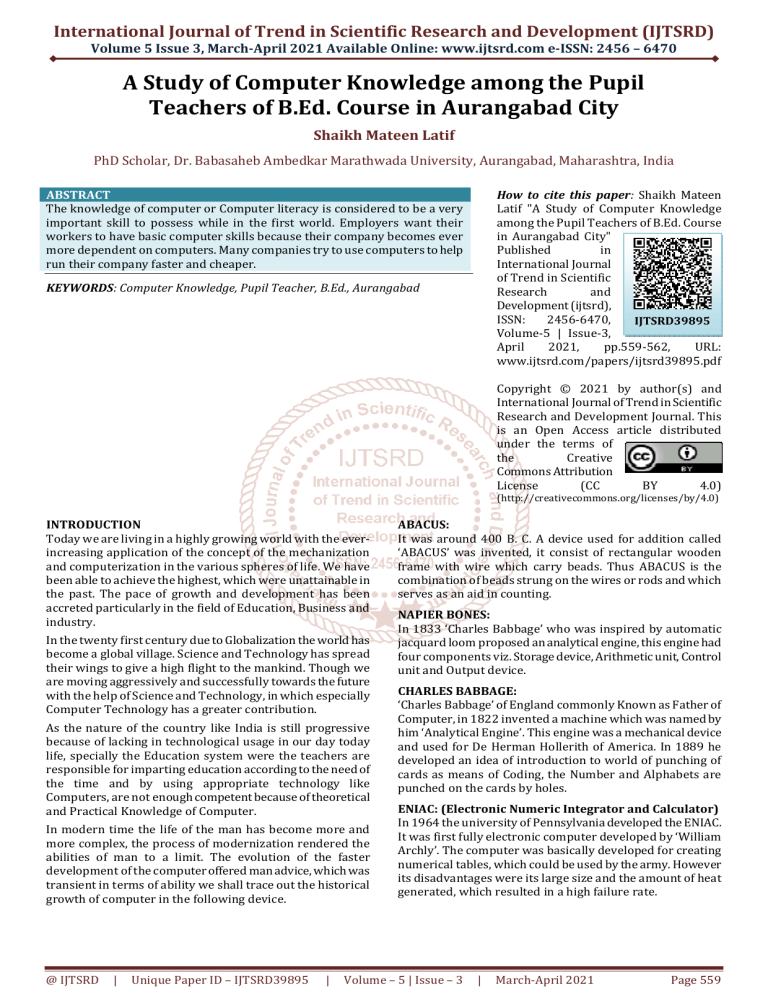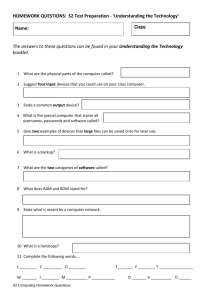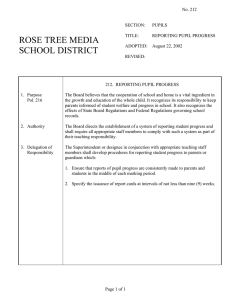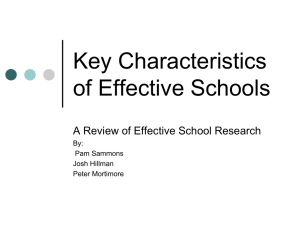
International Journal of Trend in Scientific Research and Development (IJTSRD)
Volume 5 Issue 3, March-April 2021 Available Online: www.ijtsrd.com e-ISSN: 2456 – 6470
A Study of Computer Knowledge among the Pupil
Teachers of B.Ed. Course in Aurangabad City
Shaikh Mateen Latif
PhD Scholar, Dr. Babasaheb Ambedkar Marathwada University, Aurangabad, Maharashtra, India
How to cite this paper: Shaikh Mateen
Latif "A Study of Computer Knowledge
among the Pupil Teachers of B.Ed. Course
in Aurangabad City"
Published
in
International Journal
of Trend in Scientific
Research
and
Development (ijtsrd),
ISSN:
2456-6470,
IJTSRD39895
Volume-5 | Issue-3,
April
2021,
pp.559-562,
URL:
www.ijtsrd.com/papers/ijtsrd39895.pdf
ABSTRACT
The knowledge of computer or Computer literacy is considered to be a very
important skill to possess while in the first world. Employers want their
workers to have basic computer skills because their company becomes ever
more dependent on computers. Many companies try to use computers to help
run their company faster and cheaper.
KEYWORDS: Computer Knowledge, Pupil Teacher, B.Ed., Aurangabad
Copyright © 2021 by author(s) and
International Journal of Trend in Scientific
Research and Development Journal. This
is an Open Access article distributed
under the terms of
the
Creative
Commons Attribution
License
(CC
BY
4.0)
(http://creativecommons.org/licenses/by/4.0)
INTRODUCTION
Today we are living in a highly growing world with the everincreasing application of the concept of the mechanization
and computerization in the various spheres of life. We have
been able to achieve the highest, which were unattainable in
the past. The pace of growth and development has been
accreted particularly in the field of Education, Business and
industry.
In the twenty first century due to Globalization the world has
become a global village. Science and Technology has spread
their wings to give a high flight to the mankind. Though we
are moving aggressively and successfully towards the future
with the help of Science and Technology, in which especially
Computer Technology has a greater contribution.
As the nature of the country like India is still progressive
because of lacking in technological usage in our day today
life, specially the Education system were the teachers are
responsible for imparting education according to the need of
the time and by using appropriate technology like
Computers, are not enough competent because of theoretical
and Practical Knowledge of Computer.
In modern time the life of the man has become more and
more complex, the process of modernization rendered the
abilities of man to a limit. The evolution of the faster
development of the computer offered man advice, which was
transient in terms of ability we shall trace out the historical
growth of computer in the following device.
@ IJTSRD
|
Unique Paper ID – IJTSRD39895
|
ABACUS:
It was around 400 B. C. A device used for addition called
‘ABACUS’ was invented, it consist of rectangular wooden
frame with wire which carry beads. Thus ABACUS is the
combination of beads strung on the wires or rods and which
serves as an aid in counting.
NAPIER BONES:
In 1833 ‘Charles Babbage’ who was inspired by automatic
jacquard loom proposed an analytical engine, this engine had
four components viz. Storage device, Arithmetic unit, Control
unit and Output device.
CHARLES BABBAGE:
‘Charles Babbage’ of England commonly Known as Father of
Computer, in 1822 invented a machine which was named by
him ‘Analytical Engine’. This engine was a mechanical device
and used for De Herman Hollerith of America. In 1889 he
developed an idea of introduction to world of punching of
cards as means of Coding, the Number and Alphabets are
punched on the cards by holes.
ENIAC: (Electronic Numeric Integrator and Calculator)
In 1964 the university of Pennsylvania developed the ENIAC.
It was first fully electronic computer developed by ‘William
Archly’. The computer was basically developed for creating
numerical tables, which could be used by the army. However
its disadvantages were its large size and the amount of heat
generated, which resulted in a high failure rate.
Volume – 5 | Issue – 3
|
March-April 2021
Page 559
International Journal of Trend in Scientific Research and Development (IJTSRD) @ www.ijtsrd.com eISSN: 2456-6470
GENERATIONS OF COMPUTER:
Computers are classified into a number of generations based
on the electronic technology used in constructing the
computer.
go to the local market and buy them. Thus if we wish to enjoy
the benefits of this incomparable system and wish to have a
better hold in today’s modern technology then we need to
have at least basic computer knowledge.
First Generation:
In the year 1949 to 1955 the first generation of computers
was introduced. These computers were very large in size
because of large sized vacuum tubes were used in them and
mainly used for scientific purposes.
Nowadays there are many computer coaching classes that
are being conducted at local college which offer computer
education to all irrespective of age. If we are shy and do not
wish to go to the classes we can even opt for an online
training program which could help us to have an overview of
the whole system. This way we can develop a good
understanding of how the system works.
Second Generation:
In 1947 invention of transistor has made a revolution in the
world of electronics and used in the computers. Hence from
1956 to 1965 the second generation of computers uses
transistors.
Third Generation:
In 1959 the concept Integrated Circuit came and in between
1966 to 191975 third generation computers were started
using Integrated Circuits, and were used as database
management system.
Fourth Generation:
In 1971 microprocessor was introduced and used in
computers and the fourth generations was introduced from
1975 to 1985. In this duration Large Scale integrated circuits
and very large scale integrated circuits were developed and
used in computers.
Fifth Generation:
It is not very clear now what direction the fifth generation
will take. Scientists are trying in this generation in which the
concept of Artificial Intelligence will be used.
Computers are now affecting every sphere of human activity
and bringing about many changes in industry, Government,
Education, Medicine, Scientific research, Law, Social Sciences
and even in Arts lake Music and painting. They are presently
used, among other applications, to design buildings, bridges
and machines, control Space vehicles, Assist in Railway
reservation, control inventories to minimize material cost,
Grade Examination and process results, Aid in Teaching,
Systematically store and quickly retrieve data, for
Entertainment.
The areas of application of computers are confined only by
limitations on human creativity and imagination. In fact a
computer can perform any task that can be carried out
systematically, using a precise step-by-step method.
Therefore it is essential for every educated person today to
know about a computer, its strengths, its weaknesses and its
internal structure.
In order to take the advantage of this marvelous technology
a proper computer education is a must. Today there is a high
demand for computer literates as most companies hire
people who have a good knowledge in computers. To start
with the computer education you could enroll for a basic
package which gives you brief idea about operating
computers, operating its software’s and hardware, Internet
and also Microsoft Office which could help you in our day to
day office activities like preparing letters or memos, Creating
Spread Sheets or Presentations and so on. This basic
knowledge has become a crucial element to compete in
today's job market.
Computers have made our lives simple and very convenient
by offering our needs at a click of a mouse through online
shopping thereby saving a significant amount of our time to
@ IJTSRD
|
Unique Paper ID – IJTSRD39895
|
NEED OF THE RESEARCH:
The national system of education in India employs a
curricular framework with a common core and other flexible
components. It intends to provide access and quality of
education to all. The administrative and financial controls of
the system rest jointly with the union government and the
state-level governments. In 1984, a program of computer
literacy was started on an experimental basis in government
schools. The first computer-related policy, emphasizing
computer literacy, was established as a part of the National
Policy on Education in 1986 and modified in 1992. Realizing
all of India’s intended policy goals regarding the knowledge
of computers in education will require facing several major
obstacles.
Where computers are widespread, they are also a part of
education. Computers are used in schools for many
applications such as writing papers or searching the Internet
for information. Computer skills are also a subject being
specifically taught in many schools, especially from
adolescence onward - when the ability to make abstractions
forms.
Computers as Tools for Self-Directed Learning
At one time it was possible to train young people to perform
tasks that they could then apply throughout a lifetime. The
apprentice blacksmith would learn and use the same
techniques used by his father, his grandfather before him,
and so on back through the ages. Today, however, the pace of
technological change is so great that a set of skills learned
yesterday can be obsolete in a year or so. Therefore, to be
successful, people have to be able to teach themselves, to
retool, to find for themselves the resources that they need
for learning new skills to keep pace with their changing
environments.
Computers as Tools for Collaborative Project Work
Information and service workers, those who will make up
the vast majority of the twenty-first century workforce,
typically operate in project teams. They need to be able to
communicate effectively with one another, to establish
project goals, to plan strategies for attaining those goals, to
break up the work among team members, to report their
progress to one another, to evaluate this progress, and to
synthesize their individual efforts into a final product.
Networked computers are excellent tools for such
collaborative project work. Students can use scheduling
software to plan their projects, communicate over networks
about their projects, store project components in a central
place, use individual software tools (such as word
processors, Internet browsers, and graphics programs) to
carry out specific project tasks, evaluate their progress using
online evaluation forms, and design elegant final products
for sharing with their teachers and classmates.
Volume – 5 | Issue – 3
|
March-April 2021
Page 560
International Journal of Trend in Scientific Research and Development (IJTSRD) @ www.ijtsrd.com eISSN: 2456-6470
Computers as Research Tools
An information-age job, by definition, requires that one be
able to gain access to information, and computers are
unparalleled tools for doing just that. In the past, a student
with a research project was limited to the few resources
available in his or her school or community library all too
often a few aging encyclopedias and a handful of tattered
books on a handful of school-related topics. Today, the
resources of the world are a keystroke away. Homework
help, vast libraries, reference works, museums, government
and educational archives, news reports these are but a few of
the many resources available on the Internet. Instantly, and
with little effort, the student has access not just to local
resources but to the resources of the globe.
Computers as Exploratory
One of the problems often confronted by educators is the
difficulty of getting students to envision what is being
described by all those words in textbooks. What is the
structure of a DNA molecule? What did the universe look like
seconds after the Big Bang? Just where was Crete, and how
was Minoan civilization destroyed? How does the heart
work? How did Heinrich Schliemann figure out from reading
the Odyssey where the ruins of Troy were buried? What is
the water cycle? What does the interior of the earth look
like? Computers can show students these things, not
passively, in the mode of television, but interactively. A
student can call up a map of ancient Greece and follow the
path of Odysseus through the Mediterranean from Troy to
Ithaca or can pretend to be a water molecule, enter a root
hair, travel up the stem of a plant, and evaporate into the air.
Computers can take students where they otherwise could
not go and make learning into a thrilling, self-directed
journey.
SIGNIFICANCE OF THE RESEARCH PROBLEM:
Where computers are widespread, they are also a part of
education. Computers are used in schools for many
applications such as writing papers or searching the Internet
for information. Computer skills are also a subject being
specifically taught in many schools, especially from
adolescence onward - when the ability to make abstractions
forms.
One problematic element of many (though not all)
"computer literacy" or computer education programs is that
they may resort too heavily on rote memorization. Students
may be taught, for example, how to perform several common
functions (e.g.: Open a file, Save a file, Quit the program) in
very specific ways, using one specific version of one specific
program. When a graduate of such a program encounters a
competing program, or even a different version of the same
program, they may be confused or even frightened by the
differences from what they learned. This is one reason why
major computer and software firms such as Apple Computer
and Microsoft consider the educational market important:
The often time-limited computer education provided in
schools most often lends itself to rote memorization,
creating a sort of vendor lock-in effect whereby graduates
are afraid to switch to competing computer systems.
The knowledge of computer or Computer literacy is
considered to be a very important skill to possess while in
the first world. Employers want their workers to have basic
computer skills because their company becomes ever more
dependent on computers. Many companies try to use
computers to help run their company faster and cheaper.
@ IJTSRD
|
Unique Paper ID – IJTSRD39895
|
Today, computers are no longer specialized tools used only
by scientists or engineers. They do not hum behind sealed,
glass walls in climate – controlled environments. Computer
systems are everywhere, in places you cannot see or would
not expect to find them. They are a fact of life, a common
thread that ties together our education, work, and home life.
With computers touching nearly every facet of our lives, the
issue of computer literacy becomes important.
As personal computers become common-place and they
become more powerful, the concept of computer literacy is
moving beyond basic functionality to more powerful
applications under the heading of multimedia literacy. Of
course, arguments about computers being common-place in
the first world assume that everyone in the first world has
equal access to the latest forms of technology. However,
there is a pronounced digital divide that separates both
physical access to technology and the ability to use that
technology effectively.
The researcher wants to know the knowledge of the pupil
teachers who are going to teach students in near future and
hence the knowledge of the students regarding computer is
must to check, unless and until their knowledge is not
checked the remedial measures and suggestions are not
suggested to them. Hence the researcher undertakes the
study.
Statement of the Problem:
“A Study of Computer Knowledge among the Pupil Teachers
of B.Ed. Course in Aurangabad City”.
OPERATIONAL DEFINITIONS:
Computer:
Computer is an electronic machine, which accepts data;
process the data and gives desired output.
Knowledge:
Knowledge means the knowing about computers; here the
knowledge refers to the fundamental aspects of computers
and basic skills involved in the operation of computers.
Pupil Teacher:
The students of the B.Ed. course who are taking the training
for becoming a teacher are referred as pupil teacher.
B.Ed. Course:
B.Ed. Course is the professional degree course in full called
as ‘Bachelor of Education’, and necessarily done as a basic
requirement for becoming a teacher.
Aurangabad City:
Aurangabad is one the historic city of Maharashtra State and
the capital of Marathwada region in India.
OBJECTIVES:
To study the computer knowledge among the pupil
teachers.
To study the computer knowledge among male pupil
teachers.
To study the computer knowledge among female pupil
teachers.
To compare the computer knowledge among the male
and female pupil teachers.
HYPOTHESIS:
Computer knowledge among the pupil teachers is high.
Computer knowledge among the male pupil teachers is
high.
Volume – 5 | Issue – 3
|
March-April 2021
Page 561
International Journal of Trend in Scientific Research and Development (IJTSRD) @ www.ijtsrd.com eISSN: 2456-6470
Computer knowledge among the female pupil teachers is
high.
NULL HYPOTHESIS:
There is no significant difference in the mean score of the
findings of computer knowledge among the male and female
pupil teaches.
VARIABLES:
Computer knowledge, Male Pupil Teachers and Female Pupil
Teachers.
SCOPE OF THE PROBLEM:
Area of Research:
The area of research deals with study of Knowledge of
computer among the pupil teachers in Aurangabad city only.
Content:
The present study deals with knowledge of Computer among
B.Ed students.
Unit:
The unit of the study is B.Ed students and their knowledge
about Computer.
Time:
The present study will be conducted in the year 2020.
LIMITATION OF THE RESEARCH:
Area of Research:
Present research is confined to Aurangabad city only.
@ IJTSRD
|
Unique Paper ID – IJTSRD39895
|
Content:
The study is limited about the knowledge of computer only.
Unit:
The study is limited to Basic Knowledge about computer.
Time:
The study is limited to the period of 2020.
References
[1] John W. Best and J.V. Kahn ‘Research in education’
Prentice Hall of India Pvt. Ltd, New Delhi.
[2]
Soti Shivendra Chandra & Rajendra K. Sharma
‘Research in education’ published by: Atlantic
Publishers & Distributors (P) Ltd, Rajouri Garden,
New Delhi-110027
[3]
R. A Sharma ‘Educational Research’Ist Ed., published
by: Vinay Rakheja, Near Govt, Inter College.
[4]
Agarwal J. C. ‘Educational Research’ Ist Ed. published
by: Arya Book depo Agra.
[5]
www.springerlink
[6]
www.csudh.edu
[7]
www.sosig.ac.uk
[8]
www.scholar.lib.vt.edu
Volume – 5 | Issue – 3
|
March-April 2021
Page 562




